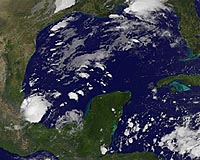| . |  |
. |
Canberra, Australia (SPX) Oct 26, 2010 Australian scientists are preparing to use the data from a new $22m array of high-tech equipment to help them probe deeper into the nation's surrounding oceans. The new technology is part of a vastly improved set of tools provided by the Australian Integrated Marine Observing System (IMOS) to study the open ocean. "What is happening in the open ocean is vitally important to all Australians and their understanding of local and regional climate," says IMOS Director, Tim Moltmann. "It drives our climate and weather extremes, is the workplace for offshore industries and maritime defence activities and contains a diversity of marine life that currently is barely described. "We need to observe this part of the earth system to understand how it's changing, and what the impacts might be on current and future generations of Australians." Carrying out research in harsh, remote regions of the planet is extremely challenging, and technology plays an increasingly important role. The open ocean observing array will include: + Autonomous profiling floats that 'sense' breaks in the sea ice to transmit their data. + Marine mammals equipped with satellite tags. + Underwater gliders that spend months at sea, controlled by land-based 'pilots'. + Huge moorings engineered to withstand some of the wildest ocean conditions. Mr Moltmann said IMOS brings together ocean and climate scientists from research institutions across the nation, including the University of Tasmania, CSIRO, Australian Antarctic Division, Bureau of Meteorology, Australian Institute of Marine Science, Sydney Institute of Marine Science, and University of Western Australia. A feature is continued collaboration with northern hemisphere partners, including the United States, France, the United Kingdom, and Korea. CSIRO oceanographer and leader of the IMOS ocean and climate node, Dr Susan Wijffels, says IMOS is helping to foster a new era of cooperation between scientific disciplines that have not traditionally worked together. "This is a unique approach to monitoring the linkage between the physical properties of oceans, such as temperature and salinity, and how they influence the marine ecosystem," Dr Wijffels says.
Share This Article With Planet Earth
Related Links CSIRO Marine and Atmospheric Research Water News - Science, Technology and Politics
 US says 96 percent of Gulf of Mexico open to fishing
US says 96 percent of Gulf of Mexico open to fishingWashington (AFP) Oct 22, 2010 US authorities Friday opened 7,000 square miles (18,000 square kilometers) of waters in the Gulf of Mexico to fishing, bringing to 96 percent of federal waters now deemed safe months after the world's biggest oil spill. The National Oceanic and Atmospheric Administration said the newest area reopened was about 80 nautical miles south of the Florida panhandle. It was the 10th reopening in ... read more |
|
| The content herein, unless otherwise known to be public domain, are Copyright 1995-2010 - SpaceDaily. AFP and UPI Wire Stories are copyright Agence France-Presse and United Press International. ESA Portal Reports are copyright European Space Agency. All NASA sourced material is public domain. Additional copyrights may apply in whole or part to other bona fide parties. Advertising does not imply endorsement,agreement or approval of any opinions, statements or information provided by SpaceDaily on any Web page published or hosted by SpaceDaily. Privacy Statement |